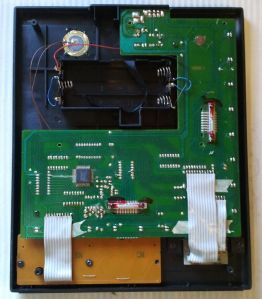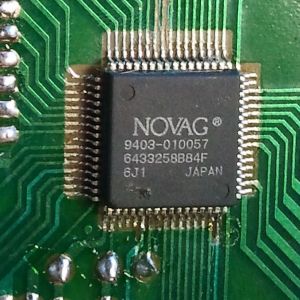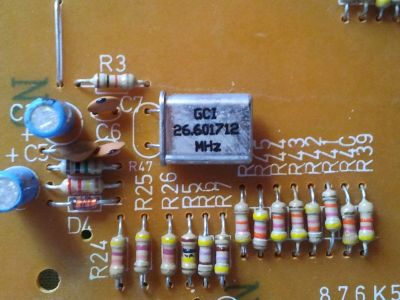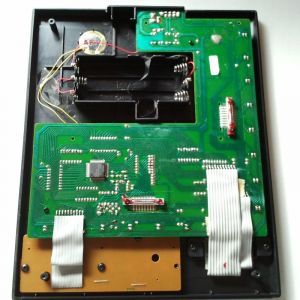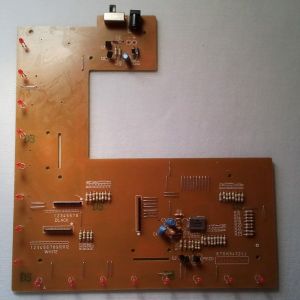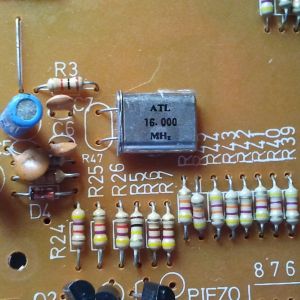Novag Aquamarine RISC II 26.6 MHz: Unterschied zwischen den Versionen
Berger (Diskussion | Beiträge) Keine Bearbeitungszusammenfassung |
Berger (Diskussion | Beiträge) Keine Bearbeitungszusammenfassung |
||
| Zeile 7: | Zeile 7: | ||
| Markteinführung = {{Erscheinungsjahr|1998}} | | Markteinführung = {{Erscheinungsjahr|1998}} | ||
| Preis = | | Preis = | ||
| Prozessor = [[H8|Hitachi H8]]/ | | Prozessor = [[H8|Hitachi H8]]/3258 ([[ROM serial|rom B84]]) | ||
[[H8|Hitachi H8]]/3214 ([[ROM serial|rom A06]]) | |||
| Prozessortyp = [[8 Bit]], [[Singlechip]] | | Prozessortyp = [[8 Bit]], [[Singlechip]] | ||
| Takt = | | Takt = 26,6 MHz (internal 13,3 MHz) | ||
16 MHz | |||
| RAM = 1 KB | | RAM = 1 KB | ||
| ROM = 32 KB | | ROM = 32 KB | ||
Version vom 27. Juni 2024, 16:02 Uhr
| Novag Aquamarine RISC II 26.6 MHz | |||
|---|---|---|---|
 |
|||
| Hersteller | Novag | ||
| Markteinführung | 1998 | ||
| CElo | 2032 | ||
| Programmierer | Kittinger, David | ||
| Prozessor | Takt | RAM | ROM |
| Hitachi H8/3258 (rom B84)
Hitachi H8/3214 (rom A06) |
26,6 MHz (internal 13,3 MHz)
16 MHz |
1 KB | 32 KB |
| Rechentiefe | BT-2450 | BT-2630 | Colditz |
| 16 Halbzüge | - | 1958 / 1972 | - |
| Bibliothek | 13.000 Halbzüge | ||
| Display | 2x 4-stellige 7-Segmentanzeige | ||
| Spielstufen | 56 | ||
| Zugeingabe | Drucksensoren | ||
| Zugausgabe | 16 Rand-LEDs | ||
| Einführungspreis | |||
| Prozessortyp | 8 Bit, Singlechip | ||
| Stromversorgung | Netz = 9V/0,3A DC (Plus außen!) / Batterie = 6 x AA | ||
| Maße | 23,5 x 28,5 x 2 cm | ||
| Verwandt | Novag Zircon II, Novag Jade II, Chess Wizard IQ V | ||
| Sonstiges | |||
| wurde ausschließlich in Spanien verkauft | |||
Review
Some of these computers, internally examined, reported the following data:
| Version | Chip | H8 Family | Quartz Crystal | VCC |
|---|---|---|---|---|
| Original | HD6433258B84F | H8/325 | 26.6 MHz | 5 V |
| Siglo XXI | HD6433214A06F | H8/3214 | 16 MHz | 5 V |
Data reported by Hitachi for that microcontroller family:
| H8 Family | ROM | RAM | Recomm. Max. Clock at 5V |
|---|---|---|---|
| H8/325 | 32 KB | 1 KB | 10 MHz |
| H8/3214 | 32 KB | 1 KB | 16 MHz |
Block Diagram of Clock Signal Generator for this two microcontrollers:
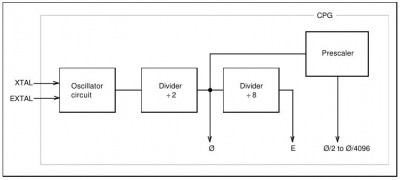 |
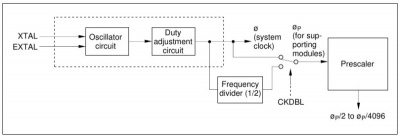 |
Clock signal in H8/325 is divided by 2 automatically, regardless of Prescaler. Therefore, in computers equipped with this microcontroller, the system clock frequency (Ø) is 1/2 of the frequency of the quartz oscillator. With H8/3214 division by 2 is optional (selected by software). Therefore, the system clock signal (Ø) may be equivalent to the quartz crystal, or 1/2.
Whereof we can obtain this table:
| Version | H8 Family | Quartz Crystal | Divider | System Clock (Ø) |
|---|---|---|---|---|
| Original | H8/325 | 26.6 MHz | /2 | 13.3 MHz |
| Siglo XXI | H8/3214 | 16 MHz | /1 | 16 MHz |
Overclocking? In the "original" Aquamarine maximum clock frequency recommended by manufacturer is exceeded, but this is possible. The manufacturer (Hitachi) sets 10 MHz as the maximum (recommended) frequency because they certifies that, under these conditions, 100% of the manufactured chips will work fine in a wide range of ambient temperatures. But it's possible that integrator (Novag in this case) decide to select those chips that work correctly even exceeding the recommended clock frequency by a certain percentage. The increase in the "original" Aquamarine is 33%
In any case, these values are confirmed when performing various comparative test between the two computers.
Testing
When the same problems are proposed on both computers, logging the time required for each problem, it's confirmed that "Siglo XXI" always solve approximately 20.3% faster.
Illustrative Example:
After performing Reset (ACL) on both computers, we select G5 Level (Mate in 5)
The next position is established, and solving time is counted:
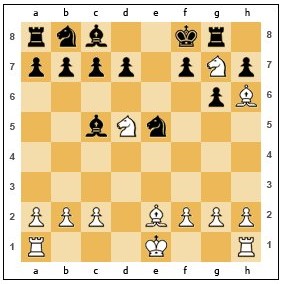
| Computer | Solving Time |
|---|---|
| Aquamarine RISC II 26.6MHz | 15min 12sec |
| Aquamarine RISC II 26.6MHz "Siglo XXI" | 12min 37sec |
"Siglo XXI" 20.4% faster
In Blitz and Mate Search levels the same result is always obtained: Aquamarine "Siglo XXI" performs calculations about 20.3% faster. But this advantage is not noticeable in long games (with more than 3 minutes per move, for example) because both seem to have the same program, and eventually both make the same decisions with exactly the same valuation per move.
Addendum
It has been reported about a "normal" Aquamarine RISC II (without "Siglo XXI" printed) with an Hitachi H8/3214, and 16MHz quartz crystal.
Pictures
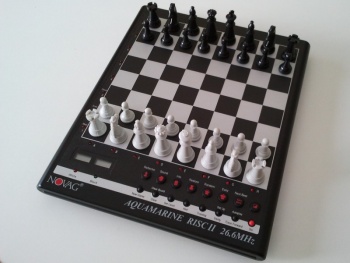 |
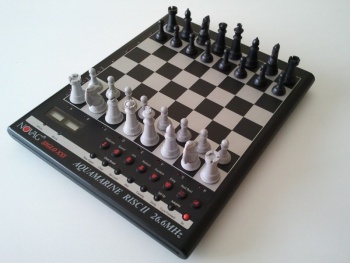 |
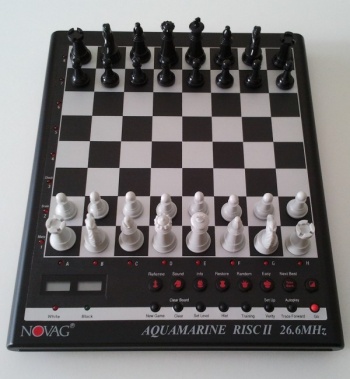 |
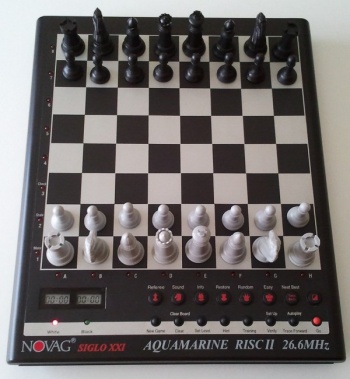 |
Inside the Chess Computer
NOVAG AQUAMARINE RISC II 26.6 MHz
-
Mainboard
-
CPU
-
Mainboard
-
Quartz Crystal
NOVAG AQUAMARINE RISC II 26.6 MHz "Siglo XXI"
-
Mainboard
-
CPU
-
Mainboard
-
Quartz Crystal



